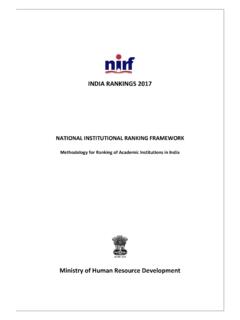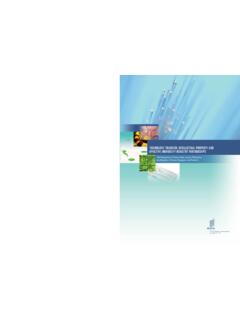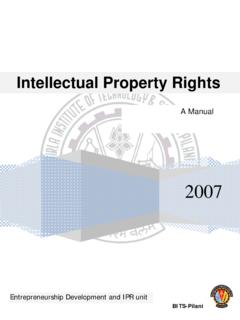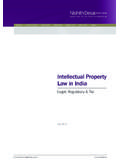Transcription of A Methodology for Ranking of Universities and Colleges in ...
1 A Methodology for Ranking of Universities and Colleges in india Department of Higher Education Ministry of Human Resource Development Government of india No. Title Page No. i) Foreword 6 ii) Preface 7 iii) Composition of Committee of National InstitutionalRanking Framework (NIRF) UGC Notification cum Meeting Notice 9 iv) Executive Summary 11 v) Salient Features 11 vi) Ranking based on Institution Categories 12 vii) Data Collection 13 viii) Implementation Details 14 Part I Parameters and Metrics for Universities Overview /Summary of Ranking Parameters 17 Cumulative Sheet 18 1. Teaching, Learning and Resources (TLR) 100 Marks 19 1 (a) Faculty Student Ratio with emphasis on PermanentFaculty (FSR) - 20 Marks 21 1 (b) Combined Metric for Faculty with PhD and Experience(FQE) - 30 Marks 22 1 (c) Metric for Library and Laboratory Facilities (LL) - 40 Marks 24 1 (d) Metric for Sports Facilities and Extra-Curricular Activities(SEC) 10 Marks 25 2.
2 Research Productivity, Impact and IPR (RPII) 100 Marks 27 2 (a) Combined Metric for Publications (PU) 45 Marks 29 2 (b) Combined Metric for Citations(CI) 45 Marks 29 2(c) Intellectual Property Right (IPR) 10 Marks 30 3. Graduation Outcome (GO) 100 Marks 33 3 (a) Combined Performance in University Examinations (UE) 50 Marks 35 3 (b) Combined Performance in Public Examinations (PE) 50 Marks 35 4 Outreach and Inclusivity (OI) 100 Marks 37 4 (a) Outreach Footprint(Continuing Education, Services) (CES) 25 Marks 39 4 (b) Percentage of Students from Other States/Countries (Region Diversity-RD) 25 Marks 39 4 (c) Percentage of Women Students and Faculty 20 Marks 39 4 (d) Percentage of Economically and Socially Disadvantaged Students (ESDS) 20 Marks 40 4 (e) Facilities for Differently Abled Persons (DAP) 10 Marks 40 5. Perception (PR) 100 Marks 41 5 (a) Process for Peer Rating in Category (PR) 50 Marks 43 Table of Contents 5 (b) Application to Seat Ratio (SR) 50 Marks 43 Part II Parameters and Metrics for College Overview /Summary of Ranking Parameters 47 Cumulative Sheet 49 1.
3 Teaching, Learning and Resources (TLR) 100 Marks 51 1 (a) Faculty Student Ratio with emphasis on Permanent Faculty (FSR) - 30 Marks 53 1 (b) Combined Metric for Faculty with PhD and Experience(FQE) - 30 Marks 54 1 (c) Metric for Library and Laboratory Facilities (LL) - 30 Marks 55 1 (d) Metric for Sports Facilities and Extra-Curricular Activities (SEC) 10 Marks 56 2. Research Productivity, Impact and IPR (RPII) 100 Marks 57 2 (a) Combined Metric for Publications (PU) 45 Marks 59 2 (b) Combined Metric for Citations(CI) 45 Marks 59 2(c) Intellectual Property Right (IPR) 10 Marks 60 3. Graduation Outcome (GO) 100 Marks 63 3(a) Combined Performance in University Examinations (UE) 50 Marks 65 3 (b) Combined Performance in Public Examinations (PE) 50 Marks 65 4. Outreach and Inclusivity (OI) 100 Marks 67 4 (a) Outreach Footprint(Continuing Education, Services) (CES) 25 Marks 69 4 (b) Percentage of Students from Other States/Countries (Region Diversity-RD) 25 Marks 69 4 (c) Percentage of Women Students and Faculty 20 Marks 69 4 (d) Percentage of Economically and Socially Disadvantaged Students (ESDS) 20 Marks 70 4 (e) Facilities for Differently Abled Persons 10 Marks 70 5.
4 Perception (PR) 100 Marks 71 5 (a) Process for Peer Rating in Category (PR) 50 Marks 73 5 (b) Application to Seat Ratio (SR) 50 Marks 73 The University Grants Commission is pleased to participate in the National Initiative on Ranking of Indian Institutions with a larger objective to improve Ranking of Indian Universities in World University Rankings. The Expert Committee, appointed for developing a Ranking system for Colleges and Universities had benefit of access to the National Institutional Ranking Framework developed by the Core Committee appointed by the Ministry of Human Resource Development. The Core Committee has done a commendable job of identifying parameters that have global appeal as well as those that are country-specific reflecting problems and prospectswoven into our cultural and social fabrics.
5 The Committee while giving emphasis on parameters that have global appeal research output, research impact, learning environment, etc. has also considered parameters like infrastructure, facilities for differently-abled persons, percentage of students from other states and other countries; percentage of women students and faculty, and percentage of economically and disadvantaged students. The Expert Committee had also given weightage to the sports and extra curricular facilities available in the campuses of Universities and Colleges , which, I believe emphasises on overall development of a student in a university or a college. I would like to put on record the commendable job done by the Expert Committee, under the Chairmanship of Prof. Chauhan, Member, UGC and Emeritus Professor, International Centre for Genetic Engineering and Biotechnology (ICGEB).
6 I would also like to acknowledge contribution of INFLIBNET centre in terms of inputs on bibliometric and citation parameters. The Centre has already developed a portal for Ranking Universities in india based on these parameters using widely-accepted Ranking formula. I believe that the Ranking framework developed for Ranking Universities and Colleges will have wider appeal across Universities and Colleges . Thousands of institutions would volunteer themselves to the Ranking exercise with an aim to assess themselves on the qualitative parameters used for Ranking of institutions and move upward on the quality spectrum to improve their Ranking in subsequent years. (Prof. Ved Prakash) Chairman, UGC Forward The Higher education system in india is large and complex. india has the third largest higher education system in the world, behind China and the United States comprising of 795 Universities , 39,671 affiliated Colleges , 10,15,696 teaching faculty and 2,37,64,960 students including 29,34,989 post-graduate and 2,00,730 research scholars.
7 The total enrolment has increased from a meagre 2 lakhs in 1947 to 238lakhs in 2013-14. Colleges , affiliated to 194 affiliating Universities , constitute the bulk of the higher education system in india contributing around of the total enrolment. The institutions of higher education in india are in need of infusion of quality and clarity on the approach of building world-class educational institutions in the Indian context and environment. New benchmarks of quality need to be defined to help overall system to move up on the quality spectrum. Research assessment and national Ranking of Indian educational institutions can play an important role in improving performance and quality of academic institutions. The Expert Committee set-up by the UGC for developing National institutional Ranking Framework (NIRF) for Higher Education Institutions under the ambit of University Grants Commission, discussed and deliberated upon reputed globally-recognized rankings of the world-class Universities and performance of Indian educational institutions in these rankings.
8 The expert committee also invited , Director, INFLIBNET Centre to make a presentation on the portal developed by the INFLIBNET Centre which is already functional, based on mainly research output and citations. This document is culmination of intense discussions and consultation held amongst the members of the Expert Committee and invitees. The Expert Committee had the benefit of expert advise from Prasad, Chairman, National Board of Accreditation, who was also a member of the Core Committee on National institutional Ranking Framework (NIRF). The Expert Committee agreed that the Ranking parameters and metrics developed by the core committee are applicable universally across all sectors and disciplines. Considering the fact that Universities in india are essentially set-up for postgraduate education and research, it was decided to assign higher percentage (40%) weightage to Research Productivity, Impact and IPR , 30 % weightage to Teaching, Learning and Resources , 5% weightage to Graduation Outcomes , 5% weightage to Outreach and Inclusivity and lastly 10% weightage to Perception.
9 Weightages assigned for Ranking of Colleges were suitably modified. While the process would involve complexities in terms of collections and authentication of data from a very large number of institutions of higher learning, the members opined that all institutions should have an opportunity to join the process of Ranking . I hope that implementation of the Ranking metrics would help Universities and Colleges to self-assess themselves on the quality spectrum, enhance their abilities and hopefully find a place in world rankings. Prof. Chauhan Member, UGC and Emeritus Professor,ICGEB Preface 1. Background This document is a part of the National Institutional Ranking Framework with emphasis on Methodology for rankinguniversities and Colleges across india . The Methodology draws from the broad understanding arrived at by the Core Committee (CC) set up by Ministry of Human Resource Development (MHRD) that defines broad parameters to be used for Ranking various Universities and institutions.
10 The Ranking parameters agreed by the Core Committee (CC) are generic in nature that have been suitably adapted for evolving a detailed Methodology for Ranking universitiesand Colleges . The main features of the Methodology suggested are as follows: i) It is recommended to set-up a Committee, which will oversee the implementation of Ranking work for the first year, after which a suitable Ranking Agency duly authorized to receive and verify the data, and declare the rankings, may be set up. ii) This document identifies a set of suitable forms in which these parameters can be easily measured and verified across a variety of Universities and Colleges . iii) A strategy is suggested for calculating scores to measure the performance of the universitiesand Colleges across each such parameter.





